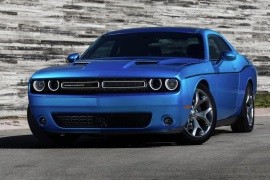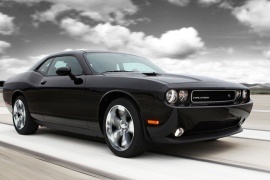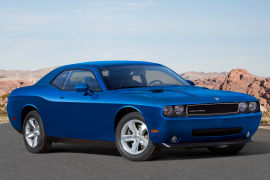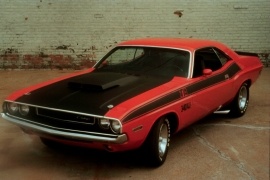DODGE Challenger Models/Series Timeline, Specifications & Photos
First production year: 1969
Engines: Gasoline
Body style: Coupé (two-door)
After introducing the third generation of the Challenger in 2008, Dodge constantly updated it for the next model years, but the first real facelift was for the 2015 model year.
When Dodge made the third generation of the Challenger, it tried to re-create the first generation of this car, and it nailed it. It was big, with a dominating attitude, and powerful. Even the lowest-powered version still gave customers over 300 ponies under the hood. But the competition was fierce against the eternal competitors, the Ford Mustang and the Chevrolet Camaro. To keep its advantages, the 2015 Challenger came with several exterior, interior, and powertrain updates. Dodge unveiled it at the 2014 New York Auto Show.
The car had new headlights that sported halo-style LED daytime running lights. Besides the halogen bulbs, Dodge also offered the option of projector-beam (HID) for the outer headlamps for improved road illumination. Furthermore, to emphasize the mean aspect of the car, the automaker added black surroundings for these. Between them, the grille sported two horizontal rectangular trims, resembling the original Challenger from 1970. Depending on the version, the car sported hood vents and air intakes.
From its profile, the Challenger revealed a long hood followed by a short, raked windshield. Its short roof ended in a typical sedan-style rear window and a long deck in the back. The profile also revealed the coke-bottle styling for the rear fenders that resembled the muscle-car era of the ‘60s. Dodge offered the Challenger in eight trim levels: SXT, SXT Plus, R/T, R/T Plus, R/T Shaker, R/T Plus Shaker, 6.4-liter Scat Pack, and 392 HEMI Scat Pack Shaker. Several other versions were added in the following model-year updates. Finally, at the back, the wide taillights flanked the Dodge lettering placed on the rear fascia, while below the bumper, the car sported side-mounted exhausts with different designs according to the engine version.
Inside, the most significant upgrade was for the Uconnect infotainment system. The touchscreen display between the vents atop the center stack controlled more than just the navigation and the stereo. It also allowed access to various technical settings, such as those for the launch-control system. In front of the driver, Dodge installed a seven-inch TFT display placed between the large analog speedometer and tachometer. The center console housed two cup holders and the gear selector for the automatic transmission. Since the car was built for performance, the front bucket seats featured high bolstered areas. At the same time, in the back, the automaker installed a bench seat where two adults could sit comfortably. Last but not least, the trunk was large enough for long trips.
Under the hood, Dodge installed a choice of V6 and V8 engines ranging between 305 hp (309 PS) and 485 hp (491 PS) for regular models. In addition, the Challenger was available with the supercharged 707 hp (717 PS) 6.4-liter V8. Another significant improvement was for the transmission, where the 2015 Challenger received a new, eight-speed, ZF8HP gearbox that sent the power to the wheels.
Dodge re-introduced the Challenger nameplate in its lineup in 2008 after more than two decades of absence, and in 2010, it refreshed it for the 2011 model year, significantly improving the big American coupe.
With the financial crisis almost gone and the Chrysler Group still standing, Dodge could flat-out with its Challenger to dominate the muscle car market. Since the model’s relaunch in 2008, it met with its old foe, the Camaro from Chevrolet. Unlike that, the Challenger had already gained some reputation, and its customers had already pointed in some directions for where the automaker had to improve the vehicle. Dodge engineers listened to them and burned the midnight oil to satisfy them. They improved it significantly in just two years since the model’s introduction. Moreover, the 2011 model year came with upgrades for the drivetrain, suspension, interior, and safety features. All these contributed to the car’s commercial success, albeit there were just minor updates for the vehicle’s exterior.
After some modest changes applied for the 2010 model year, which included lights for the door handles, the 2011 version came with a few other tweaks. Depending on the version, the Challenger featured a front fascia that sported either the model’s nameplate on the grille or the version. The lower bumper sported a new, wider, trapezoidal-shaped air intake that cooled the engine behind it, while at the bottom, a “duck-bill” spoiler painted black added some downforce to the vehicle.
Every customer praised the car’s profile, and Dodge couldn’t do too many things to improve it without spoiling it. But still, it introduced larger, 18-inch alloy wheels as standard across the range. Furthermore, depending on the package or grade, the car was available with a 20-inch set. To make things simpler, the automaker offered the 2011 Challenger in three grades: the SE, the R/T, and the SRT/8. In addition, the automaker offered a Rally Package that added dual chromed tips for the base model and a chromed fuel filler cap.
The 2011 Dodge Challenger interior boasted a new dashboard that featured a redesigned instrument panel. It still had four dials but with a white background, black lettering, and red needles. In addition, two green LED displays at the bottom of the speedometer and tachometer showed additional data. There was also a smaller, three-spoke steering wheel that replaced the four-spoke one used on the previous model. Dodge considered offering the SE with cloth upholstery and flat bucket seats, while the high-bolstered ones with sued and leather were reserved for the SRT/8 version.
But the most significant upgrades happened under the car’s skin. Besides the standard suspension offered on the SE grade, Dodge also provided customers with a sportier one that came with the Rally Package or standard for the R/T and the SRT/8. The base model was fitted with a new Pentastar 3.6-liter V6 engine that churned out 305 hp (309 PS), which was 55 hp more than on the previous base model. The mid-range came with the 5.7-liter unit, while the top-spec version was powered by a 6.4-liter (392) powerplant featuring cylinder deactivation for improved fuel efficiency. In terms of safety, ESP was standard across the range.
Dodge revived one of the most famous nameplates from the Muscle Car Era, the Challenger, which it previewed at the 2006 North American International Auto Show and started production in 2008.
After the Muscle Car Era ended in the early '70s, the Challenger nameplate went to a vanishing point, leaving enthusiasts with some Mitsubishi-related vehicles with four-bangers under their hoods. No wonder the Challenger's second generation lasted only about five years between 1978 and 1983. Fast forward to December 2007, customers could place their deposits for the brand-new 2008 Challenger, built in a 6,400 limited edition production run, with a V8 under their hoods and plenty of power to smoke their tires. Furthermore, the retro-styling was one of the best on the market, rivaled just by the Mustang from Ford. Dodge made the Challenger based on a shortened version of the platform used by the four-door Charger, another famous nameplate brought back by the American automaker in 2006.
Anyone who knew the original 1970 Challenger could recognize the front fascia translated into its modern-era 2008 successor. The quad headlights design and the black grille recessed and stuck between the hood and the body-colored front bumper were unique. Furthermore, the 2008 model year came with the famous SRT chromed badge, making the car even more appealing. A deep chin under the bumper and a pair of round fog lamps made the big coupe look even more aggressive.
From its profile, the car's proportions of its ancestor, albeit it was about six inches (15 cm) longer. Still, the long hood, the five-spoke alloy wheels, and the coke-bottle style of the rear fenders gave the original 1970 Challenger a classic look. Michael Castiglione and Alan Barrington did a great job of bringing that model into the twenty-first century. Furthermore, at the back, the large-sized coupe featured full-width taillights in a recessed panel between the trunk's lid and the rear bumper. A pair of side-mounted exhausts adorned with chromed rectangular tips completed the image of a bad-boy-looking vehicle.
Inside, the Challenger boasted one of the best finishes that left Dodge's assembly lines in Detroit. Its four-dial instrument cluster and the large four-spoke steering wheel fronted the driver's high-bolstered bucket seat. As expected, the side passenger's seat looked identical, and both were available with the SRT logo embroidered on their seatbacks. Just like the original Challenger, the 2008 model year provided enough room in the back for two other passengers, who sat on a split-folding (60/40) bench seat that could be lowered and expand the 16.2 cu-ft (459-liter) trunk. The stereo was also upgraded to modern standards and was integrated into the infotainment system, which found its place on the center stack. It allowed Bluetooth connectivity and had a USB port so customers could take their favorite music on the road.
Under the hood, all 6,400 units of the 2008 Challenger featured the 370 cu-in V8 engine, which produced 425 hp (431 PS). All that oomph was sent to the rear axle via a five-speed automatic and a limited-slip differential. As a result, the car could rocket from 0 to 60 mph (0-97 kph) in five seconds flat.
Nothing screamed more pony-car than the Challenger in 1970, even though it was the last call for the golden era of the muscle cars.
Dodge had to do something to keep its edge on the market in the pony car segment. Ford had already upgraded the Mustang with the Mach 1 and the Boss versions, Chevrolet already launched the second generation of the Camaro, and AMC gained customers with the AMX. But Dodge had a secret weapon: the Challenger. It launched in 1970 and was available with a wide choice of engines and options. Its price was decent, and the look said it all. It had all the ingredients to become a sales winner, and it was for a short period of time. And then, the increasing prices of insurance, the oil crisis, and the restrictive pollution norms in California killed the entire muscle-car segment and, along with it, the pony cars as well. Dodge continued production on the Challenger’s first generation until April 1974, but it had to drop the towel after selling almost 170,000 units.
The car’s exterior resembled the one imagined by the 1966 Charger prototype. Its recessed grille and the quad-headlight design were fresh. A chromed surrounding adorned the grille, while a chromed metallic bumper neatly integrated into the car’s bodywork was attractive. Furthermore, on the lower side of the apron, the Challenger was available with a pair of round fog lamps.
From its profile, the low-slung roofline and the coke-bottle styling of the rear fenders looked elegant and sporty at the same time. Furthermore, the side rear windows could be lowered, which led to a faux-cabriolet look, typical for a two-door hardtop. The automaker installed chromed flush door handles and mirrors and adorned the front fenders with the Challenger nameplate. At the back, the car featured a full-width taillight, interrupted in the middle only by an illuminated plaque that sported the Dodge word on it. Depending on the version, a dual exhaust came peaking under the rear valance, below the chromed bumper.
Inside, Dodge installed a modern dashboard where a four-dial instrument panel fitted with nine gauges, including a trip odometer, fronted the driver. The two front bucket seats were separated by a center console, which housed the gear stick lever and a storage compartment. An unusual feature of the vehicle was noticed on the SE grade, an overhead consolette mounted on the roof inside the vehicle. In the back, a large bench seat could accommodate three passengers, although the floor was crossed by the transmission tunnel.
Dodge launched the car in 1970 with a choice of nine engines, ranging from a 225 slant-six to the mighty 426 V8 HEMI. The Challenger boasted numerous technical features such as power front disc brakes, heavy-duty torsion bars on the R/T version with the 340 cid V8. All versions could be equipped with a three-speed manual on the floor, while later, the automaker added a three-speed automatic or a four-speed manual for selected versions.
DODGE Challenger 3.2L 3AT RWD (105 HP)
DODGE Challenger 3.2L 3MT RWD (105 HP)
DODGE Challenger 3.7L 3AT RWD (145 HP)
DODGE Challenger 3.7L 3MT RWD (145 HP)
DODGE Challenger 5.2L V8 3AT RWD (230 HP)
DODGE Challenger 5.2L V8 3MT RWD (230 HP)
DODGE Challenger 5.2L V8 4MT RWD (230 HP)
DODGE Challenger 5.6L V8 3AT RWD (275 HP)
DODGE Challenger 5.6L V8 3MT RWD (275 HP)
DODGE Challenger 5.6L V8 4MT RWD (275 HP)
DODGE Challenger 5.6L V8 4MT RWD (290 HP)
DODGE Challenger 6.3L V8 3AT RWD (290 HP)
DODGE Challenger 6.3L V8 3AT RWD (330 HP)
DODGE Challenger 6.3L V8 3MT RWD (330 HP)
DODGE Challenger 6.3L V8 4MT RWD (330 HP)
DODGE Challenger 7.0L V8 3AT RWD (425 HP)
DODGE Challenger 7.0L V8 4MT RWD (425 HP)



